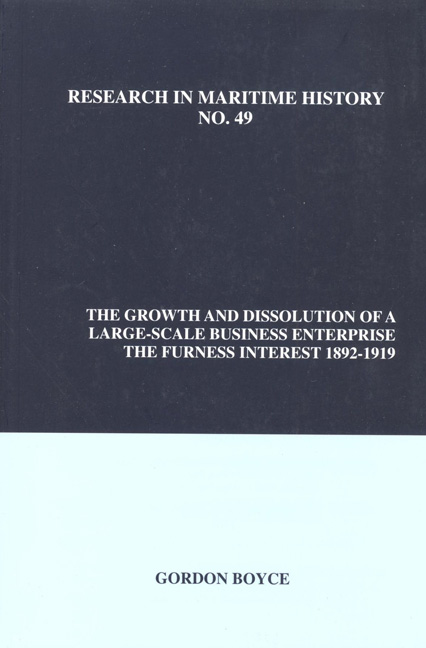Book contents
- Frontmatter
- Table of Contents
- About the Author
- Acknowledgements
- Figures and Tables
- Introduction
- Chapter 1 Furness' Shipping Services: Growth by Organic Means in the 1880s
- Chapter 2 The 1890s: Furness Withy's Expansion by Acquisition and Promotion
- Chapter 3 Diversification into the Industrial Sector, 1895-1901
- Chapter 4 Trouble on the Transatlantic Route: The Formation of the IMM and Furness' Response
- Chapter 5 The Growth of Shipping Services, 1902-1909
- Chapter 6 Industrial Operations and Performance, 1900-1914
- Chapter 7 The Growth of the Shipping Interests, 1910-1919
- Chapter 8 Structure
- Chapter 9 Finance
- Chapter 10 Holding Company Investment Activities and Intermediary Operations
- Chapter 11 Personnel
- Chapter 12 Furness
- Chapter 13 Dissolution
- Appendix 1 Development of the Combined Fleet, 1900-1919
- Appendix 2a Patterns of Ownership: The Furness Group, 1919
- Appendix 2b Reorganization of Branch Offices and Superintending Departments, 1911-1912
- Appendix 3a Fluctuations in Freights, Profits, Tonnage Afloat and Merchant Shipping Output
- Appendix 3b Output of Merchant Tonnage (Excluding Warships), 1892-1913
- Appendix 3c Fluctuations in the Price of a 7500-ton Cargo Steamer, 1898-1913
- Appendix 4 Development of the Furness Group: Principal Promotions, Acquisitions and Divestments, 1880-1919
- Appendix 5 Northern Allies and Maritime Associates
- Appendix 6 Contemporary Accounting Law and Conventions, 1845-1914
- Appendix 7 Lord Furness' Movements, 1899-1912
- Bibliography
Chapter 4 - Trouble on the Transatlantic Route: The Formation of the IMM and Furness' Response
- Frontmatter
- Table of Contents
- About the Author
- Acknowledgements
- Figures and Tables
- Introduction
- Chapter 1 Furness' Shipping Services: Growth by Organic Means in the 1880s
- Chapter 2 The 1890s: Furness Withy's Expansion by Acquisition and Promotion
- Chapter 3 Diversification into the Industrial Sector, 1895-1901
- Chapter 4 Trouble on the Transatlantic Route: The Formation of the IMM and Furness' Response
- Chapter 5 The Growth of Shipping Services, 1902-1909
- Chapter 6 Industrial Operations and Performance, 1900-1914
- Chapter 7 The Growth of the Shipping Interests, 1910-1919
- Chapter 8 Structure
- Chapter 9 Finance
- Chapter 10 Holding Company Investment Activities and Intermediary Operations
- Chapter 11 Personnel
- Chapter 12 Furness
- Chapter 13 Dissolution
- Appendix 1 Development of the Combined Fleet, 1900-1919
- Appendix 2a Patterns of Ownership: The Furness Group, 1919
- Appendix 2b Reorganization of Branch Offices and Superintending Departments, 1911-1912
- Appendix 3a Fluctuations in Freights, Profits, Tonnage Afloat and Merchant Shipping Output
- Appendix 3b Output of Merchant Tonnage (Excluding Warships), 1892-1913
- Appendix 3c Fluctuations in the Price of a 7500-ton Cargo Steamer, 1898-1913
- Appendix 4 Development of the Furness Group: Principal Promotions, Acquisitions and Divestments, 1880-1919
- Appendix 5 Northern Allies and Maritime Associates
- Appendix 6 Contemporary Accounting Law and Conventions, 1845-1914
- Appendix 7 Lord Furness' Movements, 1899-1912
- Bibliography
Summary
Just after the end of the nineteenth century, J.P. Morgan acquired in serial fashion five major transatlantic passenger lines and combined them within a New Jersey-registered holding company called the International Mercantile Marine (IMM). The process of “trustification” began in late 1900 when the US-owned International Navigation Co., along with its Red Star Line subsidiary, merged with another American firm, the Atlantic Transport Company. The following May, the combine purchased its first British line, Frederick Leyland and Co., which operated thirty-one ships. To safeguard his ties with important clients (all three of the acquired firms were customers), William Pirrie, the head of Belfast shipbuilder Harland and Wolff, decided to support the American combine by brokering an agreement for the IMM to buy the White Star Line (managed by Ismay, Imrie and Co.), another important customer in which he held a large investment. When this deal was announced publicly in April 1902, it generated pronounced dismay since White Star was the most profitable transatlantic passenger carrier. (It also operated a substantial fleet of cargo vessels and traded to Australasia.) White Star owned twenty vessels, including the largest on the British register. At about this time, the British shipping press also discovered that Morgan had agreed to acquire the Dominion Line, which traded to Canada, and that, again acting through Pirrie, the American banker had also reached an understanding with Albert Ballin of the Hamburg-Amerika Line (HAPAG) to pool passengers and freight and to coordinate routes. This agreement also included the Norddeuscher Lloyd (NDL) as well as the Holland Amerika Line in which the IMM had acquired a controlling interest through Pirrie. All three continental lines were important customers of Harland and Wolff. In the meantime, Morgan had been making overtures to Britain's remaining major passenger carrier on the North Atlantic, the Cunard Steamship Company, whose fleet comprised twenty-four vessels.
These developments presented the British shipping community with three dangers of potentially profound magnitude. First, it was clear that Mor gan was seeking to create a monopoly in the transatlantic passenger sector. Moreover, through cross-subsidization, the combine could also dislocate several trades outside the US-UK core, including the Canadian, Australasian and possibly the Mediterranean routes.
- Type
- Chapter
- Information
- The Growth and Dissolution of a Large-Scale Business EnterpriseThe Furness Interest, 1892-1919, pp. 85 - 106Publisher: Liverpool University PressPrint publication year: 2012



